
OBJECTIVE OF CHECKERS: The objective of checker is to get as many pieces from your opponents as possible.
NUMBER OF PLAYERS: 2 players
MATERIALS: 8×8 game board and 24 discs (12 of 2 colors)
TYPE OF GAME: Board Game
AUDIENCE: All ages
OVERVIEW
Checkers (Draughts) is an ancient game. The earliest known variation of the checkers game was found in Ur, Iraq and carbon-dated to around 3000 B.C.E. In Ancient Egypt, around 1400 B.C.E., Egyptians played the popular game named Alquerque, which used a 5×5 board. This game was so well-loved in the ancient world that it spread to the Western world, where it was played for thousands of years.
In France, around 1100, the idea of playing checkers on a chessboard was born. In doing so, the number of pieces expanded to 12 per side of the board. After this modification, the game was called “Fierges” or “Ferses.” After, it was quickly discovered making jumps mandatory increases the vigor of the game. This version was called “Jeu Force.”
Below, we will discuss the modern checker rules and some strategies for the game!
SETUP
This game is for two players. Checkers is a pretty straightforward game that just about anyone can play! The game consists of a game board, and 24 game discs (12 black and 12 red).
A checkerboard has 64 squares of alternating colors, 32 light squares, and 32 dark squares.
You will place your discs (pieces) on the dark squares on their side of the board. Each player will have three rows of checkers.
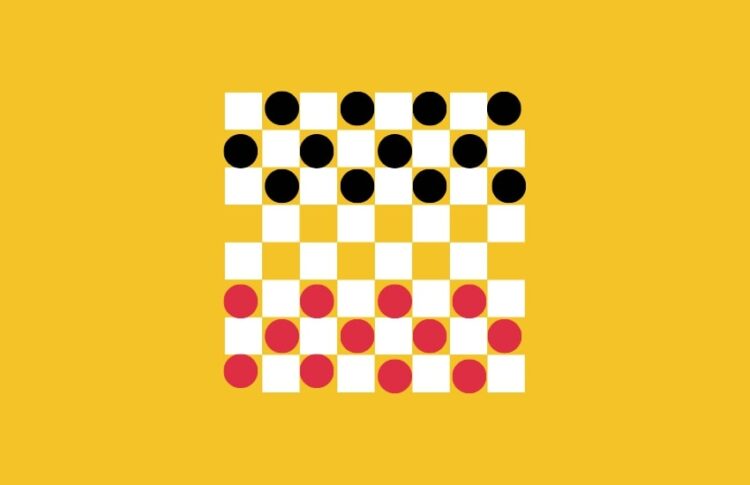
Now your board is all set up and ready to play! Black has first play, after turns alternate.
HOW TO PLAY CHECKERS
Checkers is a simple game to learn the mechanics of, but it requires a strategy to become masterful. Again this game is ancient, so cut yourselves some slack on not being pros yet.
HOW TO MOVE CHECKERS PIECES
You can only move on black squares, so the pieces move diagonally. Pieces can only move forward toward their opponent. Of course there is always an exception to the rule, but we will discuss that later.
If you are moving your disc forward and not capturing your opponent’s piece in the move, you may only move it forward one square.
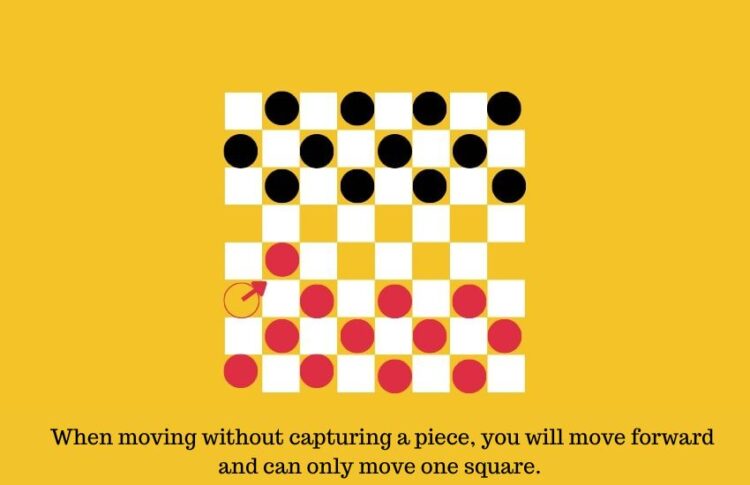
CAPTURING PIECES
In a capturing move, a piece leaps off the opponent’s piece in a diagonal line, landing on a dark square on the other side. While you can only capture one piece per jump, you can make multiple jumps in a single turn if the positioning of the pieces allows! Sounds fun, right?
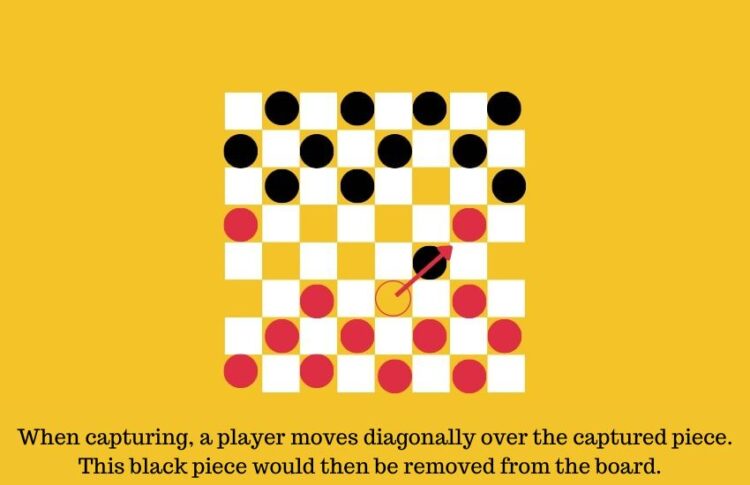
After you capture a piece, you remove it from the board and the opponent collects it.
If you can jump your opponent’s pieces, you must. However, if there is more than one capture possible from a single square, you may jump whichever piece is preferable.
KINGS
Here is that exception I mentioned earlier. Once you reach the first row of their opponent’s side of the board, you will king your piece. You will crown the checker with a piece that the opponent had captured. Kings stand twice as tall as a single piece!
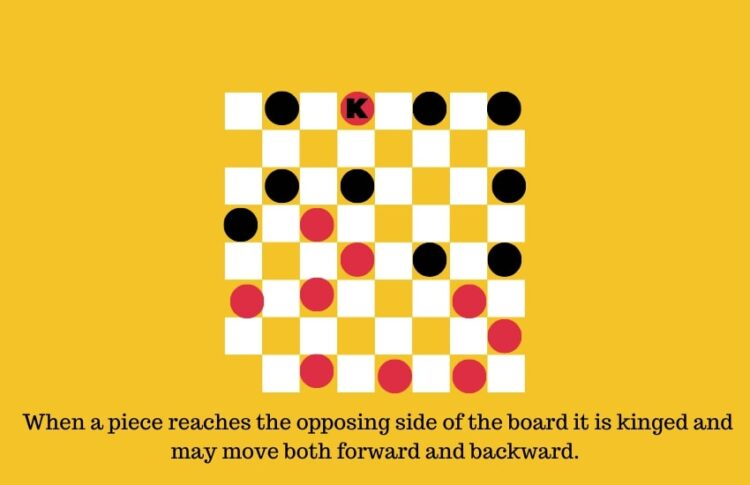

Kings can only move diagonally, as well. However, they can move forward or backward as opposed to single pieces.
Kings can also jump forward and backward (diagonally) in the same turn, a multi-direction multi-jumper, if you will.
CHECKERS STRATEGIES
There are a few strategies you can implement to have a stronger game.
- You should keep control of the center of the board.
- Building a pyramid shape will allow you to protect the back row.
- You should keep your checkers close to one another.
- Only capture pieces that do not put your checkers in danger.
- Do not be afraid to sacrifice a checker to set up for captures.
- Defending is also a great way to win. You can block off all your opponent’s pieces so they are unable to move.
END OF GAME
You win the game when your opponent is unable to make a move. This event can happen in two ways: you capture the entirety of a player’s pieces, or you block a player’s pieces from moving. Either way it is a win for you!
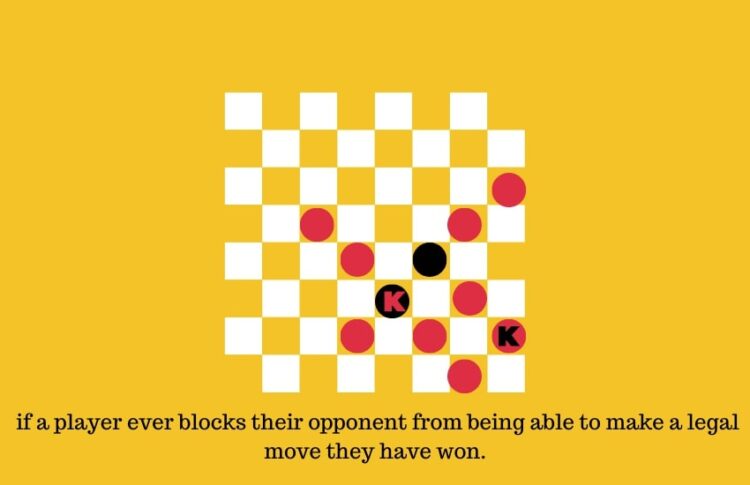
VARIATIONS
You play Suicide checkers, also known as Anti-checkers, in reverse of regular checkers. The winner of checkers in this variation is the player whose pieces are all captured first. You find the winner if their opponent are unable to move legally.
International draughts are slightly different than U.S. checkers. You play draughts on a 10×10 board with 20 pieces per player instead of an 8×8 board with 12 pieces per player. This game also observes a rule known as “Flying Kings.”
Flying Kings can move across multiple squares as long as they are unoccupied. If multiple paths exist to capture your opponent’s pieces, one must use the path that collects the most checkers. If you land in the king row during a move but can still jump backward, you must jump backward, and you do not king the checker. To king the piece, it must land exactly in that row.
Canadian checkers use a 12×12 board and 30 checkers per player. The same rules as international draughts also apply to this game.
Brazilian checkers use an 8×8 board and use rules similar to international draught rules.
Italian checkers use an 8×8 board. The central difference between Italian and US/UK checkers is that regular checkers cannot jump kings.
TOURNAMENTS
The World Checkers/Draughts Championship is an English drought tournament (also known as American Checkers or Straight Checkers) organized by the World Checkers/Draughts Federation. The tournament allows players to compete to be the World Champion.
The first men’s championship was held in the 1840s, and then the first women’s championship was held in 1993.
Do you love this game? Then check out Sorry! for another great classic. Some other great two-player games include chess and Abalone.
FREQUENTLY ASKED QUESTIONS
What Is the Difference between a Light Square and a Dark Square in the Game of Checkers?
You will only play on the dark squares of the board. You leave the light squares empty.
When You Play Checkers, When Can You Move Both Directions Forward and Backward?
Only when you have a piece kinged may you move in both directions.
How Do You Capture One of the Opponent’s Pieces?
To capture an opponent’s piece, you must jump over your opponent’s piece with your checker. You jump your opponent’s pieces diagonally, and while you can capture only one piece per jump, you may make multiple jumps with the same checker.
What Is Significant about the Back Row of the Board?
Once you have a piece reach the back row of the board (from your perspective, it is also the front row of your opponent’s side), you king your piece.
How Do You Win at Checkers?
To win, you must capture all of your opponent’s pieces or block your opponent from having any legal moves.
- 12 BEST HARRY POTTER BOARD GAMES - November 16, 2023
- 50 BEST HALLOWEEN GAMES - October 4, 2023
- 50 BEST CHRISTMAS GAMES - September 13, 2023